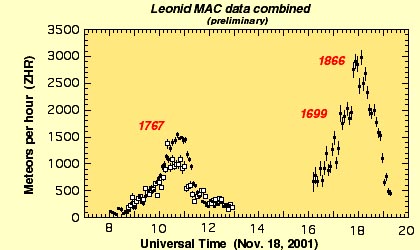|
Leonid MAC |
| home |
| View the shower |
| Mission Brief |
| Science Update |
| Media Brief |
| links |
|
The latest update on developments concerning the Leonid MAC airborne campaigns.
Update November 24, 2001
 2001 LEONID MAC MISSION A SUCCESS The meteor storm that dazzled observers in Northern America was studied from an altitude of 40,000 ft by a team of scientists in a NASA sponsored "Leonid Multi-Instrument Aircraft Campaign". Onboard the NKC-135 instrumented tanker "FISTA", the researchers trained a wide array of optical and heat sensors to the rain of meteors. After weeks of intense preparations under very difficult circumstances by the 418th Flight Test Squadron and participating researchers, the aircraft departed from Edwards AFB at 5:45 UT November 18, after a brief potentially mission-grounding loss of a walky-talky had been resolved. The flight commenced to Alabama, where the plane turned west on a slow trajectory to cover the anticipated storm profile. Soon, numerous bright meteors were detected, sometimes 3-4 at a time. On several occasions, the pilots adjusted the heading of the aircraft to help point the instruments towards sudden persistent luminous trains. In one instance by turning the aircraft 180 degrees. Close contact with aircraft operators prevented undue concern from the sudden and irregular aircraft motions. A spectacular sporadic fireball marked the the end of the night. Landing occurred around 6:30 am in morning twilight. It is still too early to know what new data were retreived during the mission. Researchers will spend much of the next year sorting out the gigabytes of data. We do know that, for the first time, the mid-infrared sensor "BASS" was successfully pointed at a persistent train. This will help clarify the role of dust in explaining the mid-IR emission of trains detected during the 1999 Leonid MAC mission and perhaps confirm the presence of surviving organic molecules in the debris. BASS was operated by Dr. Ray Russell and Dr. David Lynch of the Aerospace Corporation. Several high-resolution optical spectra were recorded by a CCD spectrograph, operated by Emily Schaller of Darthmouth College. These data probe the temperature and physical state in the hottest regions of the meteor, which determine the survivability of organic molecules. Rick Rairden of Lockheed, Palo Alto, reported the detection of several UV spectra that may help put stronger limits on the amount of organic breakup products in the meteor plasma. With the help of the NASA Ames Imaging Technology branch, High-Definition TV spectra were taken for meteor composition. Finally, slit-spectra of persistent trains were obtained by Avi Mandell of Penn State University, which may help confirm that most of the glow is due to emissions from the iron oxyde molecule. Near-real time flux measurements were reported from aircraft (Peter Gural, Mike Koop et al.) and from two ground-stations. The ground sites at Mount Lemmon Observatory, Arizona (David Holman, Jim Richardson et al.), and at Alice Springs, Australia (Morris Jones, Jane Houston Jones et al.), were hampered by clouds in the beginning of the night, but cleared up miraculously during the peak of the shower. Early results show that the 1767 and 1699/1866 dust trails dominated Leonid shower activity. The model by Brown and Cook, favoring the 1799 dust trail, was proven incorrect. Unlike models by Asher and McNaught, the peak rates of the 1699/1866 dust trail were not a factor of ten higher than that of the 1767 dust trail. The model by Lyytinen and Van Flandern and that of Jenniskens are consistent with the observations. Both are expected to evolve based on the current observations. Lyytinen also predicted the observed late peak time of the1767-dust trail encounter based on the shape of the dust trail near Earth's orbit causing an extended encounter. |

